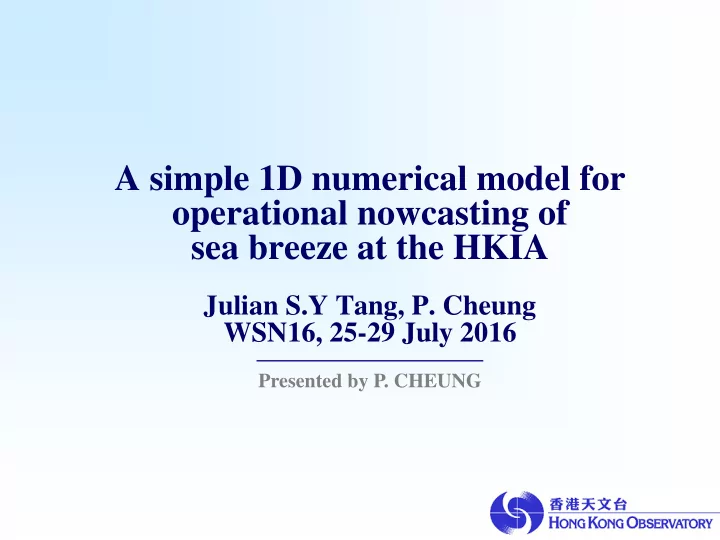

A simple 1D numerical model for operational nowcasting of sea breeze at the HKIA Julian S.Y Tang, P. Cheung WSN16, 25-29 July 2016 Presented by P. CHEUNG
• Sea breeze at HKIA – Mostly westerlies in background easterlies (here, generally refers to winds with east-component) – Onset time depends strongly on east-component – Classification: Type I, II and III (Cheng, 1999) Type I (The above figure was sourced from Cheng, 1999)
Type II
Type III
• Sea breeze at HKIA – Vertical cross section of sea breeze (sensed by LIDAR) Thickness of sea breeze behind intrusion head ~ 200-300m (Source: Weather On Wings , No.19, June 2003, Hong Kong Observatory)
• Dynamical aspect U : background zonal wind (isolated) ρ j H =1,000m ρ i L =10,000m (by tuning) Notation: u <0 for anticlockwise circulation
• Iteration – Evolution of modelled circulation speed Land-sea differential of air temperature (to be determined in consideration of the thermal aspect of the model) – Evolution of modelled time ( n th step from base time)
• Thermal aspect ( H- d a ) ( d a )
• Solar radiation flux diffuse air mass effect effect of cloud cover, F component (Meinel & Meinel, (Kasten & Czeplak, 1976) 1980) solar zenith angle extraterrestrial solar radiation where (Kasten & Young, 1989)
Solar radiation flux at n th time step of a model run: Sun Cloud cover: F n Cloud cover: OCF* forecast for future hour / actual for present hour Solar zenith angle computed for z n the modelled time ( t n ) on given day of the year by astronomical Earth surface formula *Remarks: OCF stands for objective consensus forecast (Cheung, Leung and Tang, 2015).
• Temperature of land surface – Surface of semi-infinite homogeneous slab (Lienhard and Lienhard, 2008) albedo effect convective loss to air + drain to bulk of landmass where radiative loss
• Temperature of sea surface – 1m thick homogeneous thermal-active layer albedo effect convective loss to air where radiative loss
• Temperature of air on land – 200m thick homogeneous thermal-active layer heating due to convective loss from land surface where convective loss to upper air
• Temperature of air on sea surface – [Similar to air on land] heating due to convective loss from sea surface where convective loss to upper air
• Effect of temperature advection – Temperature decrement of air on land (cold advection of sea breeze): – Temperature increment of air on sea surface (warm advection of land breeze): where
• Temperature of “upper” air – 800m thick homogeneous layer above thermal-active layer to top of circulation Average of air Reduced with on land and air height at fixed lapse rate, γ on sea surface
• Land-sea differential in air temperatures – mean over the air column from surface to top of circulation Recall
• Supplementary exclusion tests – Westerly sea breeze is not expected to occur at HKIA if: • Background wind bearing north-component > 7m/s; or • Background wind bearing south-component > 2m/s; or • Winds on high ground bearing south-component > 8m/s
• Tuning [using 3 months of data] to obtain – Drag coefficient, linear: k =0.0001/s – Horizontal extent of circulation: L =10,000m – Heat transfer coefficient at land-air interface: h’ la ≈ h la =45W/m 2 K – Heat transfer coefficient at sea-air interface: h sa =5W/m 2 K – Heat transfer coefficient between thermal-active air and “upper” air: h au =5W/m 2 K
• Initialization – Start with u 0 =0m/s and latest observations at base time for other variables (apart from a few exceptions) • Time step in iteration: ∆t =300s – Model run half-hourly during 05-17H (not run if U<0 or westerlies at R2C at base time) • Threshold for sea breeze occurrence: u n + U <-1m/s – If threshold is not reached before modeled time 1730H, then westerly sea breeze is not expected to occur on that day.
• Webpage for displaying model input/output
• Verification – 18 months “out-of-sample” data (not used in tuning) – Predicted vs actual for • Sea breeze occurrence on the day • Sea breeze onset hour (in case of predicted and actual occurrence) – Anemometer at the centre of northern runway as the reference point for actual
• Result – Prediction sea breeze occurrence on the day • POD=0.69 • FAR=0.30 • CSI=0.53 • Accuracy=0.78 (vs random predictions with forecast rate matching with “climatological” base rate: 0.53)
• Result – Prediction of sea breeze onset hour
• Result – Prediction of sea breeze onset hour • Overall accuracy: 0.76 (vs “climat”: 0.58) ± 1 hour window
• References – Cheng, C.M., 1999: Characteristics of sea breezes at Chek Lap Kok, Hong Kong Observatory Technical Note No.96. [Available online at http://www.hko.gov.hk/publica/tn/tn096.pdf]. – Cheung, P., Y.Y. Leung and S.Y. Tang, 2015: An algorithm for generating location-specific NWP total cloud cover forecast with potential application to sea breeze forecast at the Hong Kong International Airport, 29 th Guangdong-Hong Kong-Macao Seminar on Meteorological Science and Technology, Macao, 20-22 January 2015. [Available online at http://www.hko.gov.hk/publica/reprint/r1162.pdf]. – Kasten, F., and G. Czeplak, 1980: Solar and terrestrial radiation dependent on the amount and type of cloud, Solar Energy , 24 , 177–189. – Kasten, F., and A.T. Young, 1989: Revised optical air mass tables and approximation formula, Appl. Optics , 28 , 4735-4738. – Lienhard, J.H. IV and John H. Lienhard V, 2008: A Heat Transfer Textbook (3rd Ed.), Phlogiston Press, Cambridge, Massachusetts, 229. Meinel, A.B. and M.P. Meinel, 1976: Applied Solar Energy ─ An Introduction, Addison -Wesley – Publishing Co., Reading, Massachusetts.
Recommend
More recommend